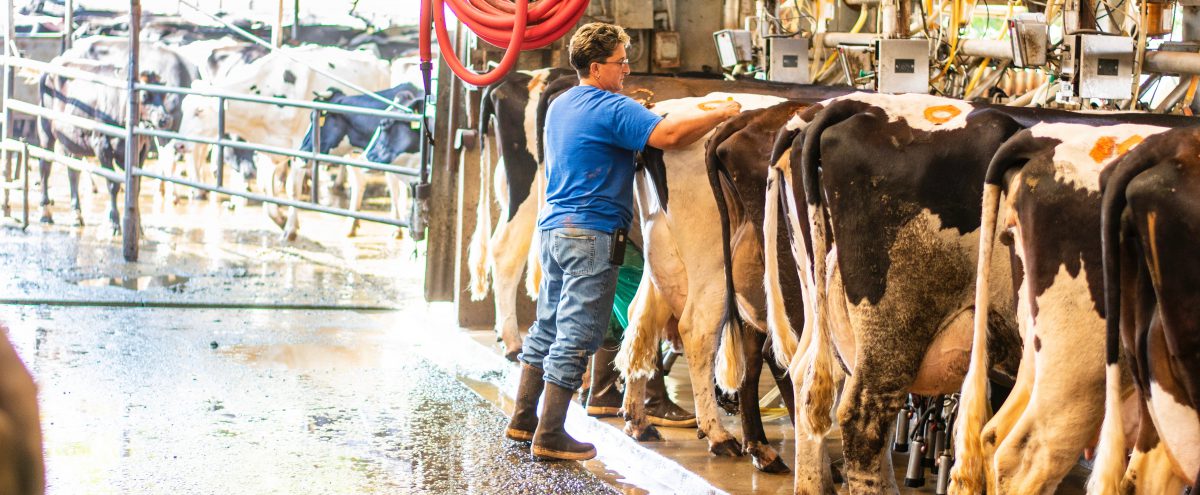
File photo.
The new year hasn’t started quite so happy for U.S. dairy operators, as they enter a fifth year of significantly low prices paid for their milk.
But some in the industry say the solution to the American problem may lie to the north, and on Tuesday a few dairy operators attending the World Ag Expo here heard about Canada’s milk-pricing system from a Canadian dairy operator, Ralph Dietrich.
He was one of a group of Canadian dairy representatives invited to speak in recent weeks in California and other states about their pricing system.
“You have to have a fair [milk] price for farmers, and the key word is ‘fair,’” he told the audience during his seminar put on by the California Dairy Campaign.
And key to that in Canada has been a supply-management system in which a determination is made annually on how much Canadian milk is needed, resulting in quotas on how much milk each dairy in the country may produce.
If too much is produced, by law that excess milk can be processed into products that can be stored long term, including powdered milk., cheese and butter. But if that surplus gets too high, dairies can face fees and not getting paid for their milk, along with the possibilities of having to dump excess milk and selling cows.
This system first was developed in the mid 1960s, when Canadian dairies were facing low milk pricing issues like those U.S. have been facing for more than four years, Dietrich noted.
Over most of that that time, dairies have been paid less than what it cost them to produce their milk.
That has resulted in large numbers of dairies here shutting down or being sold, particularly here California, the nation’s primary milk-producing state.
In fact, milk and milk products were the state’s top agricultural product produced based on sales in 2017 – the latest figure available – totaling more than $6.56 billion.
A big part of the U.S. problem is too much milk is being produced here, pushing down prices, said Dietrich, noting that his country’s system – adopted nationally there in the 1980s – offers better cash flow to dairies and ensures they can make profits on their milk.
“It’s meant to give the farmers a fair rate of return.”
In addition, Dietrich said, a big part of the Canadian system involves strongly enforcing trade agreements to ensure only the amount of milk from foreign countries specified in those agreements comes into Canada.
The CDC hosted the Ag Expo to rally support among dairy producers to support the Sustainable Milk Inventory System Act, federal legislation the Turlock-based trade group representing dairy operators developed with the California Farmers Union to create a U.S. milk pricing system similar to Canada’s “as a long-term solution to the serious structural problems faced by the United States dairy industry. SMISA was designed to allow for regional cost and supply differences and to allow farmers to control those regional requirements,” states literature passed out during the meeting.
At least in California, dairy operators already succeeded in altering their milk pricing system, changing from prices set monthly by the state to one set by the federal government that took effect Nov. 1 – a move intended to slightly raise the prices dairies here get for their milk, though it still falls short of getting dairies here paid enough to break even.
CDC Vice President Mark McAfee, who spoke after Dietrich, noted there were dairy operators from Canada in the Ag Expo audience with herds of 200 or fewer cows making a profit, while here, small dairies have been hardest hit by pricing issues, leaving larger ones with thousands of head still struggling to survive.
And the problem doesn’t just affect dairies, as the losses of dairies can hurt the communities and businesses around them.
As such, McAfee said he was disturbed only 11 people showed up for the Ag
Expo meeting, four of them Canadian dairy people and a few more journalists. Organizers noted much bigger attendances at other recent meetings with Canadian dairymen in Hanford and Elk Grove and attributed the low turnout Tuesday to a seminar on improving dairy profitability occurring next door at the same time, which was much better attended.
For his part, McAfee said he had not yet spoken with a dairy operator who doesn’t support going to a pricing system similar to Canada’s, but few of them seem willing to voice those opinions to their dairy cooperatives.
“It’s really sad we don’t have more dairymen here,” he said. “If we don’t hang together, we are going to hang individually.”
But not all in the industry are supporting the CDC’s legislative effort, which would include regional quotas on U.S. milk production.
Andre Mikhalevsky, CEO of California Dairies Inc., California’s top milk processor, raised concerns that quotas on U.S. dairies could hurt the ability to meet the milk demand from foreign markets.
Instead, he suggested a system in which dairy operators regularly get market signals “so people can look at their production based on what’s going on with international prices” and adjust their production up or down accordingly, rather than having federally-imposed quotas.
He said 15-18 percent of U.S. milk products goes to foreign markets, and losses of some of those buyers would further reduce the prices dairies here are paid for their milk.
But in its literature, the CDC notes that in its proposed bill, “Milk requested for use in export by processors would be included in regional dairy supply demand.”
Organizers of Tuesday’s presentation said they hoped for a bigger audience at a second presentation by Dietrich scheduled for the next day at the Tulare County Agricultural Commissioner’s office, across the street from the International Agri Center, where the World Ag Expo was held.







